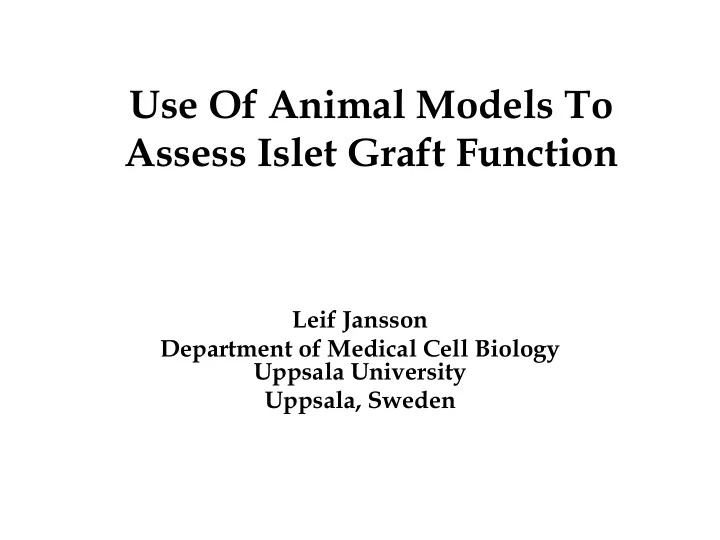

Use Of Animal Models To Assess Islet Graft Function Leif Jansson Department of Medical Cell Biology Uppsala University Uppsala, Sweden
Experimental Transplantation • Samples of the isolated human islets can be implanted into normoglycemic and/or hyperglycemic animals (nude mice or rats) - freshly isolated - after culture
Experimental Transplantation • Allows for evaluation, at different times after implantation - short term (<3-4 days) - long term
Animals VS Humans • Relevance of diabetes models • Absence of autoimmunity • Number of islets needed for cure • Implantation organs • Glucotoxicity • Lipotoxicity
Implantation Site • Renal capsule • Liver (intraportally) • Spleen • Omental pouch • Other
Experimental Transplantation SHORT TERM LONG TERM • Ability to induce • Cellular composition normoglycemia of graft • β -cells • Revascularization • Other cells • Reinnervation • Hormone release • Amyloid deposits
Experimental Transplantation SHORT TERM LONG TERM • Ability to induce • Cellular composition normoglycemia of graft • β -cells • Revascularization; • Other cells • Reinnervation • Hormone release • Amyloid deposits
Ability To Induce Normoglycemia • Number of islets needed? • When after implantation does normo- glycemia occur? • Dependent on implantation organ?
Experimental Transplantation SHORT TERM LONG TERM • Ability to induce • Cellular composition normoglycemia of graft • β -cells • Revascularization; • Other cells • Reinnervation • Hormone release • Amyloid deposits
Experimental Transplantation SHORT TERM LONG TERM • Ability to induce • Cellular composition normoglycemia of graft • β -cells • Revascularization; • Other cells • Reinnervation • Hormone release • Amyloid deposits
Cellular Composition • Immunostaining of histological sections • Evaluation of number of different cell types and degree of fibrosis - Fibroblasts/myofibroblasts (stellate cells) - Macrophages/Dendritic cells - Nerve cells/Schwanns cells - Endothelial cells/pericytes
Cellular Composition • Immunostaining of histological sections • Evaluation of number of different cell types and degree of fibrosis - Fibroblasts/myofibroblasts (stellate cells) - Macrophages/Dendritic cells - Nerve cells/Schwanns cells - Endothelial cells/pericytes
Endothelial Cells • Vascular density, number of endothelial cells • (Blood perfusion) • pO 2 • Metabolism • Capillary blood pressure • Lymphatics • Vascular dysfunction
Day 0-1 Post-Tx Apoptosis β -cells Necrosis O 2 , nutrients Insulin, metabolites Davalli et al, Diabetes 45:1161, 1996
Revascularization • Revascularization initiated within 1-3 days and concluded within 7-14 days. Menger et al Diabetes 38(Suppl 1):199, 1989 • VASCULOGENESIS Formation from angioblasts • ANGIOGENESIS - Sprouting - Intussusceptive growth
Vascular Density • Bandeiraea simplicifolia (BS-1) • Carlsson et al, JCEM 87:5418, 2002 • von Willebrand actor • Ulex lectin • CD31
Decreased Growth Potential? Pregnant rats, gestational day 15 Johansson M et al, FASEB J, 19: A1713, 2005
Improve Islet Revascularization • Stimulation of Islet Angiogenesis + - Angiostatic factors e.g. α 1- Pro-angiogenic factors, e.g VEGF, antitrypsin, endostatin, FGF, HGF, MMP-9 thrombospondins,TIMPs Vasir et al, Diabetologia 43:763, Lou et al, Diabetes 48:1773, 1999 2000 Tillmar and Welsh JOP 5:81, 2004 Vasir et al, Transplantation Mattsson et al, Pancreatology, in 71:924, 2001 press Bergers et al, Nat Cell Biol 2:737, 2000
Vascular Organization Bonner-Weir and Orci, Diabetes 31:883, 1982
In Vivo Microscopy In vivo microscopy with Evans Blue
Endothelial Cells • Vascular density, number of endothelial cells • (Blood perfusion) • pO 2 • Metabolism • Capillary blood pressure • Lymphatics
Blood Perfusion • In vivo microscopy with cross correlation • Laser-Doppler flowmetry • Hydrogen gas clearance • All these techniques can be used on the same graft
Endothelial Cells • Vascular density, number of endothelial cells • (Blood perfusion) • pO 2 • Metabolism • Capillary blood pressure • Lymphatics
Microdialysis Diameter 200 µm
Anaerobic Metabolism One-month-old islet graft non-diabetic diabetic Carlsson et al, Am J Physiol Carlsson et al, Surgery 132:487, 284:E499, 2003 2002
Endothelial Cells • Vascular density, number of endothelial cells • (Blood perfusion) • pO 2 • Metabolism • All these parameters can be studied in the same graft
Experimental Transplantation SHORT TERM LONG TERM LONG TERM • Ability to induce • Cellular Cellular composition composition • normoglycemia of graft graft of • Surviving β -cells • Revascularization Revascularization; ; • • Other cells • Reinnervation Reinnervation • • Hormone release • Amyloid Amyloid deposits deposits •
Studies Of Hormone Release • Ability to induce normoglycemia • Removal of graft and in vitro perifusion (excludes livers) • Perfusion of graft-bearing organ (graft vasculature) • The latter two allows for studies also of glucagon and somatostatin
Kidney Perfusion
Insulin Release Human Islets • Biphasic release from islets in normoglycemic recipients • Impaired release in hyperglycemic recipients • Jansson et al; J Clin Invest 96:721, 1995
Retrieved Islets from Liver One-month-old islet grafts Control Islets Retrieved Islets Retrieved islet visualized by Neutral Red Mattsson et al, Diabetes 53: 948, 2004
Intrahepatic Graft • Revascularization occurs from hepatic artery, and only to a minor extent from portal vein Andersson et al, Diabetes 38(Suppl 1): 192, 1989
Liver Vascular Anatomy Botini et al, Liver Int 25:861, 2005
Intrahepatic Grafts • Morphological studies to asses the degree of fragmentation • New in vivo imaging techiques; -MRI -Optiplex
Experimental Transplantation SHORT TERM LONG TERM • Ability to induce • Cellular composition normoglycemia of graft • Surviving β -cells • Revascularization; • Other cells • Reinnervation • Hormone release • Amyloid deposits
Islet Amyloid Westermark et al; Metabolism 48:448, 1999
Amyloid Deposits • Amyloid occurs in 73% of human islet grafts within 2 weeks after implantation into nude mice ( Westermark et al; Metabolism 48:448, 1999 ) • Initially amyloid is formed intracellularly ( Westermark et al; Upsala J med Sci 108:193, 2003 )
Conclusion • Experimental islet transplantation of human islets offers unique possibilities to assess graft function in both the short and long term perspective
Acknowledgements • Arne Andersson • Göran Mattsson • Birgitta Bodin • Astrid Nordin • Per-Ola Carlsson • Johan Olerud • Åsa Johansson • Richard Olsson • Magnus Johansson • Fredrik Palm • Cecilia Johnsson • Lisbeth Sagulin • Caroline Kampf • Eva Törnelius • Örjan Källskog • Joey Lau
Recommend
More recommend